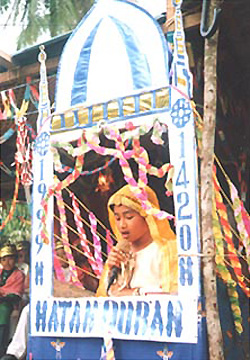| 8. Dragon Quest If I am asked how I practice area studies, I will be speaking about the village studies that I have been engaged in for the last fifteen years (for more details, see "Experiences of the Twentieth Century"). The longitudinal fieldwork project, which may be called “experiences of the twentieth century of an Indonesian village,” is my “dragon quest.” The village I refer to is my “favorite village” in Sumatra. Ever since 1984, I have tried to visit this village every year, even if only for a few days at a time. During the last twenty or thirty years, the society and economy of Southeast Asia have changed dramatically and I am keenly aware of these changes reflected in this small village. As well as pursuing various aspects of these changes, in a manner close to real time and in a longer time frame too, I would like to try to consider what kind of period the twentieth century was, as experienced by the village of Kotodalam. To do so, I hope, will eventually lead to the same question about the Japan’s experiences of the twentieth century. In this fieldwork, one of the things that interests me, naturally enough, is history. In considering history, I keep two things in mind. One of these is in reconstructing history, to try to set out from concrete changes in very common things related to the villagers’ way of life, such as clothing, food and housing. One of the mainstays of this inquiry is consideration of the changes in economic/occupational activities as well as the ecological transformations that accompany such changes. The changes in more abstract aspects such as power relationships, family relationships and mentality, are built on an understanding of the transformations in simple, concrete matters that I have already mentioned. Another thing that concerns me is understanding what one “sees” in the village, not as something which has remained unchanged, but as something which has the history of its own transformation. In fieldwork, another aspect that I must bear in mind is recognition that Kotodalam village does not exist in a vacuum or on its own but in a much broader context. The village is situated in an “area” made up of a multi-layered hierarchy: Kuantan region, Indragiri Hulu regency, Riau province, Minangkabau cultural area, Sumatra island, Indonesia, the Malay world, Southeast Asia and so on. To understand social change in Kotodalam, one must pay attention not only to change within the village itself, but also to the history of the relationships between the village and these areas of the multi-layered hierarchy. In doing so, particular importance must be attached to matters such as the development of means of transport and communications, the circulation of people, things, money and information, and, in broad terms, state policy and trends in the international economy. Persistent concern with history and area, “time” and “space,” and moreover with the interactions between these two dimensions – this might be said to be my stance underlying the practice of area studies. As for interdisciplinarity, mine is one-man interdisciplinary operation, not the work of a team. Naturally, there is a limit to the scholarly fields that can be taken up by one person, and one has to set up one’s priority. In my case, the priority is made up of three disciplines: i.e., anthropology, history, and social psychology.
KATO Tsuyoshi |
